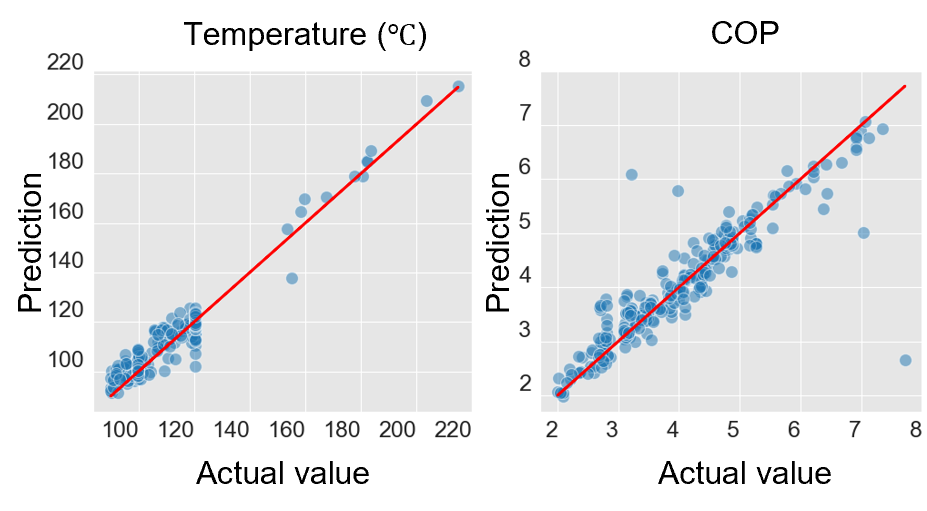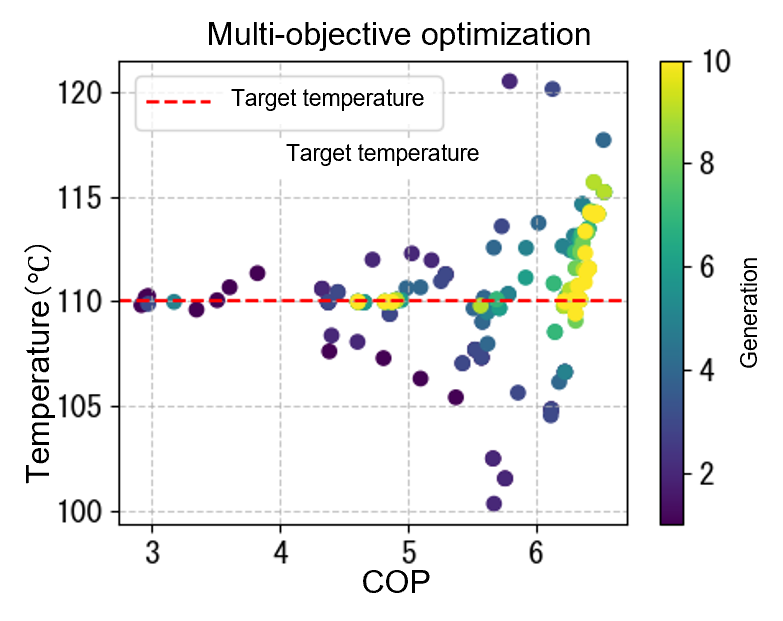In pursuit of a carbon-neutral society, the development of highly efficient thermal energy conversion technologies for both heating and cooling is becoming increasingly important. Currently, to improve the energy efficiency of next-generation industrial complexes—such as cold chains, data centers, and direct air capture (DAC) systems—there is a pressing need for thermal management systems capable of operating under large temperature glides, ranging approximately from -30℃ to 150℃. To address this challenge, an advanced Lorenz cycle (ALC) utilizing the organic Rankine cycle has been proposed. In this study, we constructed a surrogate model for a heat pump based on the ALC and explored high-efficiency operating conditions through multi-objective optimization.
1. Prediction of Temperature and Coefficient of Performance (COP) Using Multi-Sigma®
Using Multi-Sigma®, a surrogate model was constructed based on cycle simulation data of a heat pump for water heating. This surrogate model demonstrated high prediction accuracy, with correlation coefficients of 0.925 for temperature and 0.888 for the coefficient of performance (COP), which represents energy efficiency.
Explanatory Variables:
- (A) Alternative refrigerant composition ratio
- (B) Heat source flow rate [ton/h], (C) Cooling source flow rate [ton/h]
- (D) Heat source temperature [℃], (E) Compressor pressure [MPa]
- (F) Refrigerant flow rate [ton/h]
Target Variables:
- Temperature [℃]
- COP

2. Factor Analysis of Temperature and Coefficient of Performance (COP) Using Multi-Sigma®
The temperature was positively influenced by the heat source temperature and negatively influenced by the cooling source flow rate.
The COP was positively influenced by the cooling source flow rate and negatively influenced by the refrigerant composition ratio.

3. Tailor-Made Optimization Using Multi-Sigma®
Under the specified conditions of the target system (see note), multi-objective optimization was conducted with the aim of maximizing the COP at a temperature of 110℃ (±0.1℃), resulting in the following optimal operating conditions: Under these conditions, a temperature of 110.03℃ and a COP of 6.22 were achieved.
Note: Heat source flow rate: 344.1 ton/h, Cooling source flow rate: 113.1 ton/h,
Heat source temperature: 75°C


A surrogate model capable of accurately predicting the behavior of complex heat pump systems was efficiently constructed by utilizing Multi-Sigma®, enabling easy implementation of factor analysis and multi-objective optimization. These results are expected to contribute to energy conservation and CO₂ reduction in both industrial and residential sectors.
Reference Material: NEDO Leading Research Program / Advanced Lorenz Cycle (ALC) Thermal Management Technology
(NEDO: New Energy and Industrial Technology Development Organization, a Japanese national R&D agency under the Ministry of Economy,
Trade and Industry)
(1) https://www.nedo.go.jp/content/800019340.pdf (2) https://www.nedo.go.jp/content/100974246.pdf
